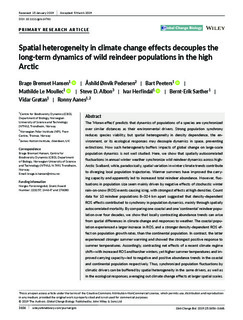| dc.description.abstract | The ‘Moran effect’ predicts that dynamics of populations of a species are synchronized over similar distances as their environmental drivers. Strong population synchrony reduces species viability, but spatial heterogeneity in density dependence, the environment, or its ecological responses may decouple dynamics in space, preventing extinctions. How such heterogeneity buffers impacts of global change on large‐scale population dynamics is not well studied. Here, we show that spatially autocorrelated fluctuations in annual winter weather synchronize wild reindeer dynamics across high‐Arctic Svalbard, while, paradoxically, spatial variation in winter climate trends contribute to diverging local population trajectories. Warmer summers have improved the carrying capacity and apparently led to increased total reindeer abundance. However, fluctuations in population size seem mainly driven by negative effects of stochastic winter rain‐on‐snow (ROS) events causing icing, with strongest effects at high densities. Count data for 10 reindeer populations 8–324 km apart suggested that density‐dependent ROS effects contributed to synchrony in population dynamics, mainly through spatially autocorrelated mortality. By comparing one coastal and one ‘continental’ reindeer population over four decades, we show that locally contrasting abundance trends can arise from spatial differences in climate change and responses to weather. The coastal population experienced a larger increase in ROS, and a stronger density‐dependent ROS effect on population growth rates, than the continental population. In contrast, the latter experienced stronger summer warming and showed the strongest positive response to summer temperatures. Accordingly, contrasting net effects of a recent climate regime shift—with increased ROS and harsher winters, yet higher summer temperatures and improved carrying capacity—led to negative and positive abundance trends in the coastal and continental population respectively. Thus, synchronized population fluctuations by climatic drivers can be buffered by spatial heterogeneity in the same drivers, as well as in the ecological responses, averaging out climate change effects at larger spatial scales. | nb_NO |

